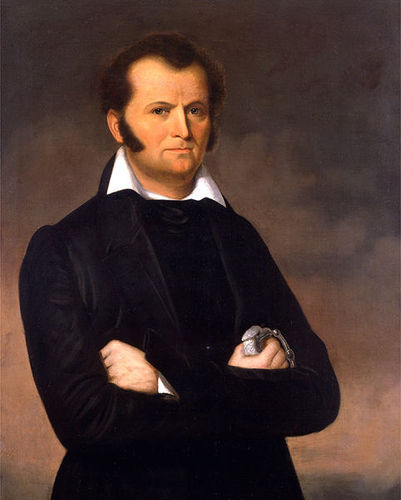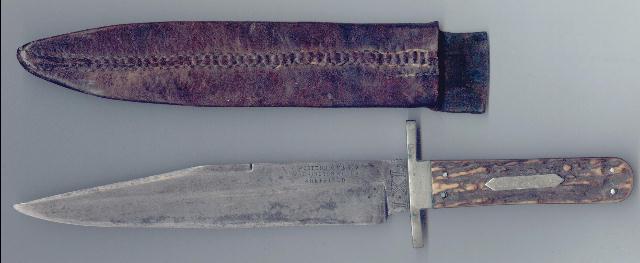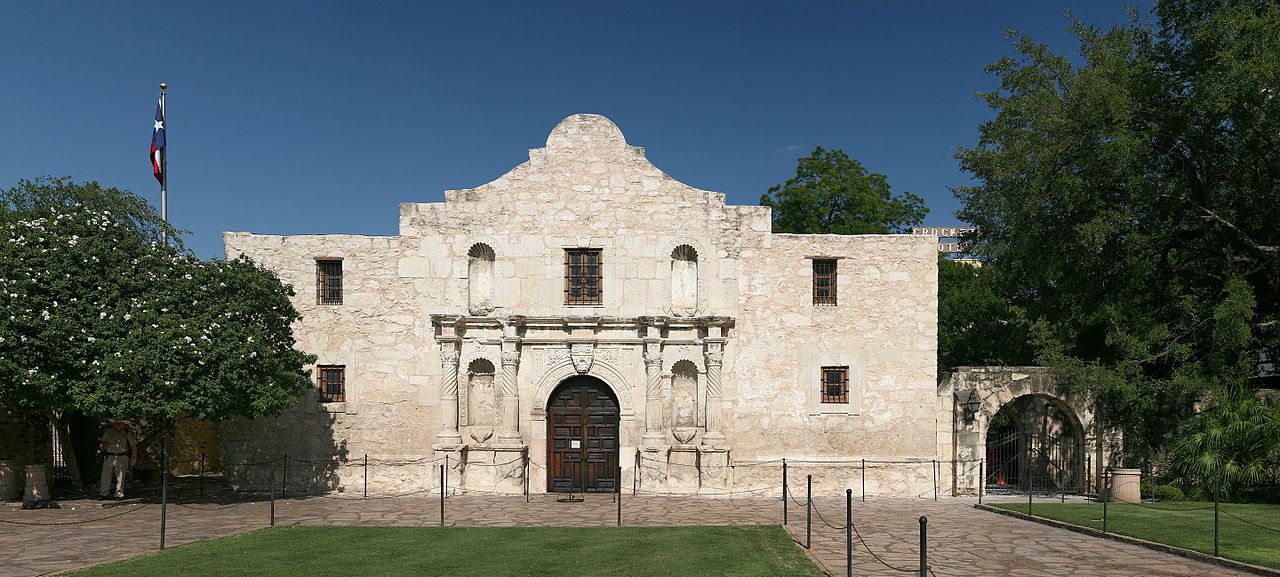
Walter Worthington Bowie.
“‘Col.’ James Bowie.”
“Col.” James Bowie, (Rezin Bowie, Sr. James Bowie.) fourth son of Rezin Bowie, Sr., and his wife, Elve Ap-Catesby (Jones) Bowie, was born at Elliott Springs, Tennessee, in 1795, and while still a child removed with his parents to Louisiana. He was a sugar-planter, and together with his brother, Rezin P. Bowie, owned several very valuable estates in La Fourche and Rapides Parishes, and in the Opelousas District. On the “Arcadia” plantation the brothers introduced the first steam mill for grinding sugar cane ever used in the State, mules having been the motive power prior to that date. He left the active management of their lands to his brother, and took more interest in politics, especially in the trend of events in the neighboring Republic of Texas. Yet he was a very wealthy man for that era, and at the time of his marriage, when certain provisions were made for the bride, he stated his property to be worth about two hundred and ten thousand dollars. The Arcadia plantation sold for ninety thousand dollars, and in the will he made just before entering the Texan Army, much property was mentioned and handsome bequests were made to the son and daughter of his deceased brother Stephen.
April 22, 1831, at San Antonio de Bexar, James Bowie was married to Maria Ursulita, daughter of Don Juan Martin de Veramandi, Governor of Coahuila and Texas, and his wife, Don Maria Joseffa Navarro, both Castilians by birth and education. Mrs. Bowie is said to have been one of the most beautiful women of the South, and when on the street with her distinguished husband they were the “observed of all observers.”
James Bowie is described as six feet tall, slight, but graceful and very muscular; gray or hazel eyes, and chestnut-brown curling hair. He wore short side whiskers and his face is said to have been singularly handsome. His portrait owned by his great nephew shows a strong, determined face, with traces of sorrow. In his right hand he grasps the hilt of a sword. So much has been said and written of this famous man that it is difficult to separate the false from the true in narrating his eventful career. In disposition he is represented as cool, determined and enterprising. Although not possessing the sparkling talents of his brother Rezin, he was however endowed with much native eloquence. His oration at a dinner given in New Orleans to General Jackson, and a speech before the Council of State at San Antonio in 1835, are mentioned as most able and eloquent. But it was as a soldier that he shines forth in all his greatness. As colonel of Texas Rangers he gained a great reputation at the battle of San Saba, November 2, 1831. The Indian tribes which were then so powerful and so dangerous called him “Fighting Devil.” His Texan followers, who idolized him, called him “the young lion.” The battles with the Indians and Mexicans, at Nocogdoches, Conception, and “Grass Fight,” in 1835, were occasions when James Bowie displayed his great military genius and intrepid courage. It is said that “to him the meaning of the word fear was absolutely unknown.”

Most of his time was spent in Texas, whose independence he was constantly scheming to accomplish, and was therefore hated and dreaded by the Mexicans. Both in Texas and in Louisiana there were at that early period many desperate characters, and everyone went armed to the teeth. Titles to the new lands were constantly being disputed and many enmities were fostered. In his section of the country the duello was a recognized law of the social system; from that appeal there was no retreat; the man who flinched would have been publically branded as a dastard. It is not surprising that James Bowie, sensitive and proud, brave to recklessness, and when aroused, as fierce as the hunted tiger, should in such a community be frequently involved in desperate personal affrays. Though tolerant of opposing opinions, always courteous in bearing and polished in manners, he yet would not brook the presence of an enemy, and believed all difficulties should be settled promptly on the spot. An unyielding adversary he pursued unrelentingly, but was ever ready to forgive when properly approached. His power of will was remarkable, and in the presence of real danger the fiery impulse of his nature was instantly subdued into cool caution, though the flash of his bright eye and the compression of his thin lips told in a moment that he considered himself in the presence of an enemy. His name has been the synonym of personal bravery, and a hundred tales are told of alleged duels and quixotic encounters in which he is made to figure as a hero. Many of them are without foundation, though unhappily he was the principal actor in a number of bloody and desperate altercations. These fights were seldom if ever pre-arranged, but took place upon the accidental meeting of the belligerents.
The “Sandbar duel,” as it was called, which took place on a little island in the Mississippi River opposite Natchez, September 19, 1827, has been more written of, perhaps, than any other of his numerous fights. Some of the writers alleging that more than a dozen men lost their lives in the affray. The following statement of that celebrated fight is based on a letter written two days after the duel by one of the participants, and an article in a Southern paper, published a short time after the occurrence. For many years a feud existed between two parties in the Parish of Rapides, on Red River. On one side was Col. James Bowie, Gen. Momfort Wells, Samuel Wells, General Cuney, Dr. Cuney, and McWhorter. On the other Dr. T. H. Maddox, of Charles County, Maryland; Maj. Morris Wright, of Baltimore; Col. Robert A. Crain, of Fauquier County, Virginia; Alfred and Edward Cary Blanchard, of Norfolk, Virginia (the latter the father of Senator N. C. Blanchard), and Dr. Denny, composed the leaders of the two parties. Their quarrels finally resulted in arrangements for the fight on the Sandbar, the principals, however, being Dr. Maddox and Samuel L. Wells, the others as witnesses, seconds, and surgeons. After two ineffectual exchanges of shots, Wells and Maddox shook hands, but Cuney stepped forward and said to Colonel Crain, “This is a good time to settle our difficulty;” Bowie and Wright also drew, and the firing became general. Crain killed Cuney and shot Bowie through the hip. Bowie drew his knife and rushed upon Colonel Crain. The latter, clubbing his empty pistol, dealt such a terrific blow upon Bowie’s head as to bring him to his knees and break the weapon. Before the latter could recover he was seized by Dr. Maddox, who held him down for some moments, but, collecting his strength, he hurled Maddox off just as Major Wright approached and fired at the wounded Bowie, who, steadying himself against a log, half buried in the sand, fired at Wright, the ball passing through the latter’s body. Wright then drew a sword-cane, and, rushing upon Bowie, exclaimed, “damn you, you have killed me.” Bowie met the attack, and, seizing his assailant, plunged his “bowie-knife” into his body, killing him instantly. At the same moment Edward Blanchard shot Bowie in the body, but had his arm shattered by a ball from Jefferson Wells.

This ended the fight, and Bowie was removed, as it was supposed, in a dying condition. Of the twelve men who took part in the affray, Wright and Cuney were killed, Bowie, Crain, and Blanchard badly wounded; the remaining seven men escaping any serious injury. Colonel Grain, himself wounded, brought water for his adversary, Colonel Bowie. The latter politely thanked him, but remarked that he did not think Crain had acted properly in firing upon him when he was exchanging shots with Maddox. In later years Bowie and Crain became reconciled, and, each having great respect for the other, remained friends until death. The knife used by Colonel Bowie was the one fashioned from a file by the plantation blacksmith and given to James by his brother, Rezin, as previously mentioned. This knife, it is asserted, was used by Col. James Bowie in nineteen deadly encounters. It finally was given by him to the actor, Forest. But the terrible reputation it had gained while in the hands of James Bowie gave it the name which is now applied to all weapons similarly fashioned. It is eight inches long, broad, single-edged, and with a curved point. The “bowie-knife” is now known as one of the most effective arms of its kind manufactured, and takes precedence over the old dagger.
It is said that on one occasion James Bowie and a neighboring Spanish planter, descended of a haughty Castilian family, became involved in a difficulty and decided to fight it out with knife and dagger. Their left hands were tied together, and, as the Spaniard drew his arm back to strike, Bowie thrust forward and drove his awful knife through his antagonist’s body; then cooly cutting the cords that held them, allowed the corpse of his adversary to sink to the ground.
Though he gained such a terrible reputation as a duelist, he is especially noted for his efforts to free Texas from her Mexican oppressors. His name is revered and honored to this day by the citizens of that great State, where a movement is now on foot to erect a monument commemorating his brave deeds and gallant death. The latter occurred in the Alamo, March 6, 1836. General Houston had directed Colonel Bowie to raise a company and cooperate with his advance against Santa Anna. In Houston’s correspondence with Governor Brown he states he had selected Colonel Bowie for this important service on account of his great ability, perfect coolness in the presence of danger, and remarkable courage. The sudden appearance of the Mexican Army rather disarranged the plans of Houston, and Col. Bowie with a small body of rangers became separated from the main army and joined Colonel Travers (a North Carolinian by birth) at San Antonia. Upon the approach of the enemy, the Texans, comprising but 185 men all told, fortified themselves in an old mission known as “The Alamo,” possessing strong stone walls, but otherwise unfit for a fortress. Here on February 26 they were besieged by Santa Anna with an army variously estimated as numbering between four and six thousand men. Bowie had been stricken down with typhoid fever, and a Mexican woman known as an experienced nurse was brought into the building to attend him before it had been surrounded. Santa Anna demanded Travers to surrender, but he defiantly refused and was supported by the other leaders, including Bowie and the noted Davy Crockett. For eight days the little band fought day and night, often hand to hand with their savage assailants. Travers seeing that the fort must shortly fall, called the men around him and told them of the probable fate which awaited them, but said he would remain and fight it out. He then drew a mark on the floor with his sword and requested all who wished to stand and fall with him to cross the line to his side?the others might endeavor to escape by cutting their way through the enemy under cover of darkness. Every man except one it is said stepped to the side of Travers, and Colonel Bowie, who was too weak to stand, had his cot taken up by two men and carried across the line. The old Mexican nurse who lived to be more than a hundred described the events which followed. She was known as Madam Candelaria, and for forty years was pensioned by the State of Texas, until she died in January, 1899. Colonel Bowie became weaker and weaker, finally delirious, and died about three o’clock on the morning of March 6, a few hours before the last assault was made by Santa Anna. Every man sold his life desperately. Crockett, with a cutlass, stood at bay with his back to the wall and cut down his assailants until shot. Not a single man was left alive. After the carnage was over and the heroes of this modern Thermopylae had all been slain, their corpses were burned by the savage Santa Anna, who lost in the eight days fight against one hundred and eighty-five men, more than two thousand of his best troops.

“Remember the Alamo” became the war cry of the Texans, and Santa Anna, a short time afterwards, had his army annihilated and himself taken prisoner with that shout ringing in his ears.
Three years before the death of Colonel Bowie he lost his wife and two infant children by cholera. They were on a visit at the time to her father, and the latter also fell a victim to the scourge. Colonel Bowie did not again marry, and left no descendants to inherit his indomitable will and fearless spirit.
All contemporaries of this noted man agree that notwithstanding his reputation as a duelist, he never provoked a quarrel in his life, but, on the contrary, prevented many. He was a man of singular modesty and sweetness of disposition, with a reverence for women and a fondness for children; ever ready to protect the weak; in fact, nothing at all of the desperado about him. He neither drank, swore or gambled, but possessed “that desperate courage which makes one a majority,” and his name became a terror throughout the Southwest to that reckless class of law-breakers who infest a new country. He always dressed with good taste, and his extreme politeness and fascinating manners captivated those who knew him best. The perilous adventures of his early life heralded his name to the country coupled with exaggerated accounts of desperate deeds, and he was thus credited with many sanguinary acts entirely foreign to his really generous and heroic character.
Text prepared by:
- Caleb Boesch
- Hudson Gerald
- Bruce R. Magee
- Cason Pyles
- Caleb Yates
Source
Bowie, Walter Worthington. The Bowies and Their Kindred. A Genealogical and Biographical History.Washington, Press of Cromwell Bros, 1899. Google Books. Web. 10 May. 2015. <http://books. google.com/ books?id= bzhLAAAAIAAJ>.
